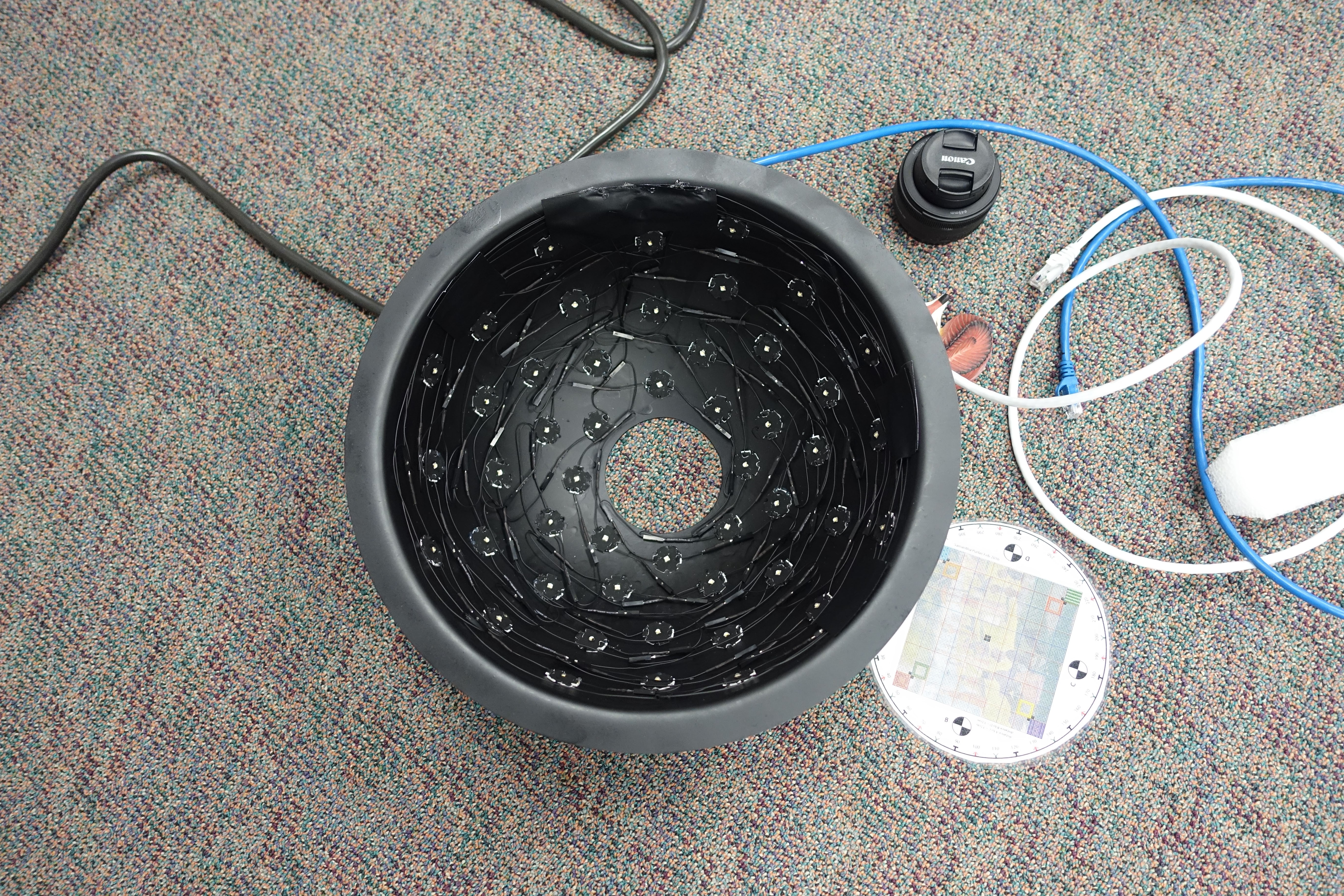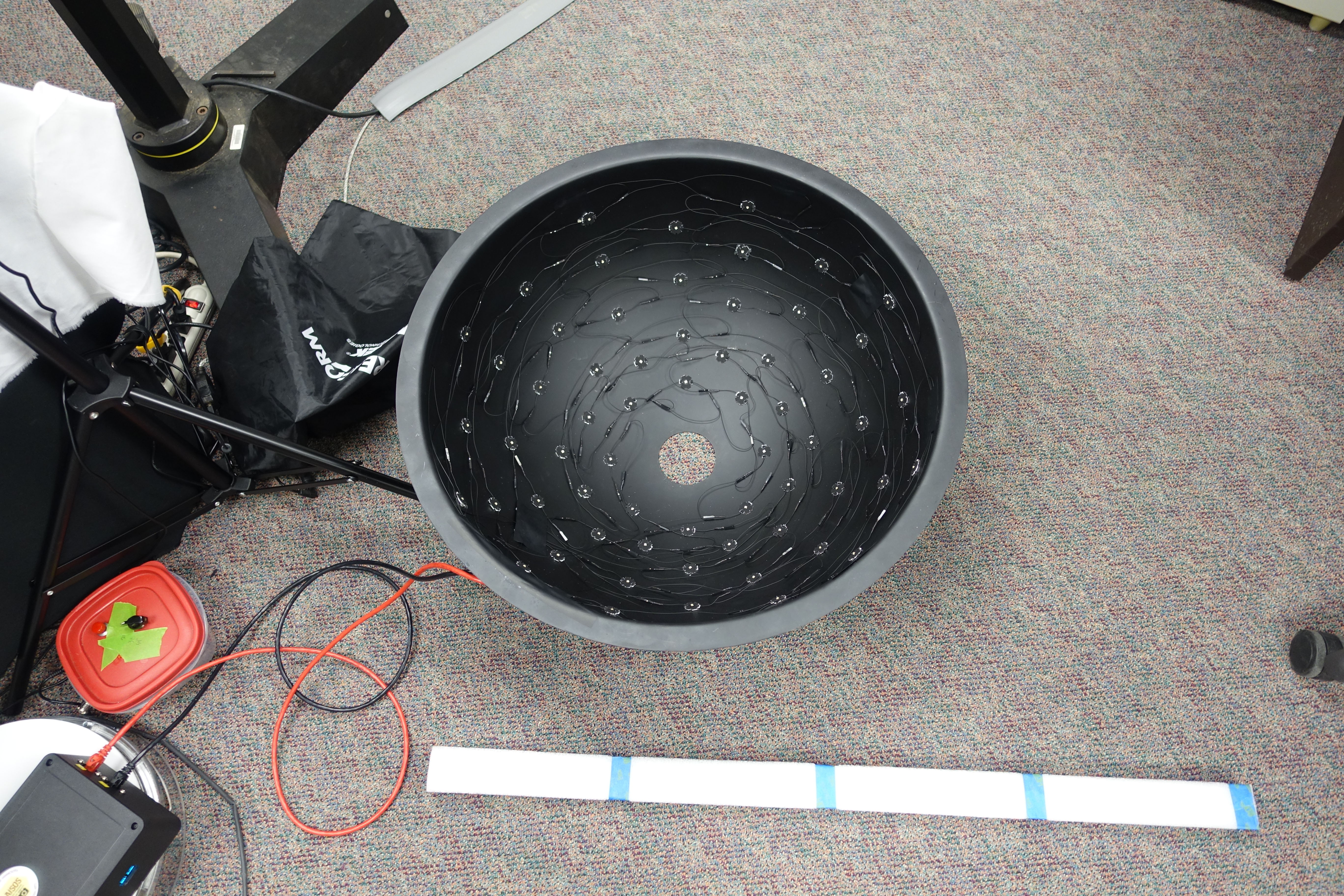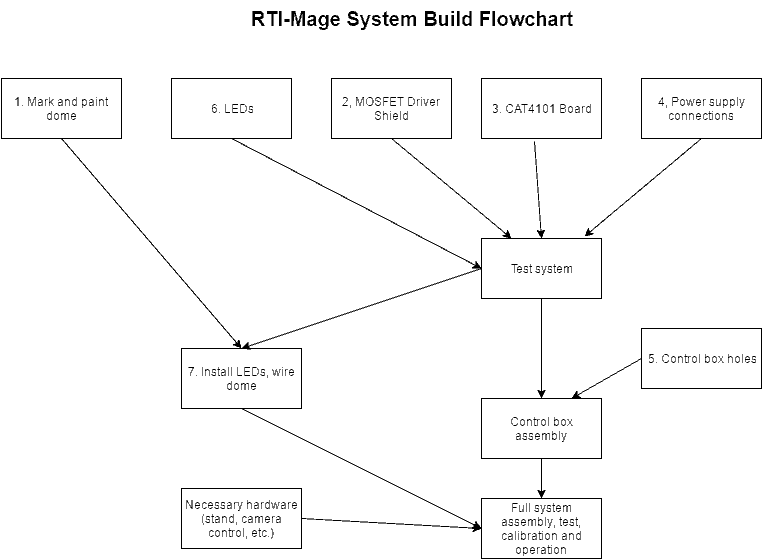-
CAT is back in the bag!
04/25/2023 at 22:21 • 0 commentsEven though the US maker of CATA4101 LED Driver chips (ON Semiconductor) has discontinued them, looks like they're still available from Chinese suppliers. Try this link at AliExpress for a listing of vendors who carry them.
-
The CAT Is Out Of The Bag.
11/05/2022 at 19:33 • 0 commentsON Semiconductor, the maker of the CAT4101 LED driver that is a critical component of this system, has discontinued this item. So, as of now, this project is no longer practical. I am looking for an acceptable substitute, but as of yet have not found one. There are alternative approaches to creating an RTI dome, some of which are far simpler than the one outlined here, but each has a set of drawbacks. If I come up with a reasonable solution, I'll post it here.
-
Blacker Than Black
04/10/2017 at 05:38 • 0 commentsIn order to minimize scattered light from the inside of the dome, it needs to be painted a flat/matte black. In the instructions, a flat black spray paint or chalkboard paint is specified, but you will still get some scattered light from both of those. It hasn't been a problem until now, but I've been doing some RTI on shiny metal surfaces that are doing a great job of picking up scattered light from the dome surface, resulting in odd artifacts. So I've been poking around for a solution.
Vantablack would be an ideal solution, as it absorbs up to 99.965% of visible light. However, it's not really available in commercial form, and the only paint version of it is dedicated to exclusive use by one artist. That has pissed off a number of other artists, one of whom has created a quasi-clone of it called Black 2.0 that he is offering for sale. Not cheap (150 ml for about $30 including shipping from the UK). I've just ordered a bottle, and will check out whether it's worth the price..
-
News
03/11/2017 at 22:12 • 0 commentsA few items of interest....
1. Just got back from the "Illumination Of Material Culture" symposium on RTI at the Metropolitan Museum of Art in NYC. Full house of 115 attendees, lots of great presentations and conversations. Videos of some of the presentations are online at the Met's Facebook page.
2. Just posted a slightly-revised version of the RTI Processor software. Discovered that problems might occur if you try to process two sets of data simultaneously with the RTI fitters. Now there's a popup that cautions you against running two sets of data at one. You can always run in batch processing mode to get around this limitation. Source code isn't up for this yet, and I am working on a bigger update that will vastly speed up processing of groups of data, so I'll hold off on updating the source code until then.
3. Jean Roc Morreale, in the IT department for archaeology, Département du Pas-de-Calais, has transferred the build documentation over to a read the docs web page. Looks really nice, and I will probably keep the build instructions as current as possible on both that site and the PDFs on this site, and bail on updating the instructions on the Hackaday website. He's also translating the instruction to French prefatory to having a system built.
4. The University Of Minnesota has built two domes based on my design, one small and one big. Reports are that it works exactly as intended. Here are a few photos they sent me:
![]()
![]()
![]()
-
Not Dead Yet (nor pining for the fjords)
03/01/2017 at 19:09 • 0 commentsBeen very busy recently, but still planning further additions/enhancements to this project. That's why it's not marked as completed. I have just uploaded the source code for the RTI Processor utility that simplifies the job of processing the data (but there will be additional enhancements to that as well shortly).
-
Happy Holidays!
12/26/2016 at 05:29 • 0 commentsSince it's Christmas today, a small present. I've broken down the "logs" section of the PDF build instructions into categorical sections, cleaned them up, and put the new versions up in the Files section. One of the new sections deals with Assembly Logistics, where I break down the assembly into modules that can be done concurrently by multiple people; using this approach, a small group of people should be able to build a system in a weekend of work. I've also created a flowchart that shows this breakdown; you can see it in the PDF file, I've uploaded an SVG version of it to the File section, and you can see it below:
![]()
-
The Difference Between A Comma And A Dot
12/12/2016 at 22:03 • 0 commentsGot an email telling me that the RTI Processor program was throwing up an error at startup concerning a bad conversion from string to double. Threw me for a minute, until I realized that the emailer was from France (thanks, Jean-Roc!). The .lps file loaded by the program when it starts has light positions in string decimal format, where the decimal point character is the standard US ".". In France, that character is a ",", so the program was labeling that string as unconvertible since it had a non-standard decimal point character. This was easy to fix since the subroutine where that problem arises is no longer needed - deleted that, and the problem went away. Also added a check for the ptmfitter.exe program required to generate PTM-format datafiles; if it doesn't find it, it disables the PTM fitting options, and sends you to the website where you can download the needed files. The new RTI Processor executable program is now up in the Files section; the source code will be up shortly.
-
Anybody Want To Buy A Gently-Used RTI Dome?
11/30/2016 at 18:18 • 0 commentsNow that I've completed the basic build documentation for the Hackaday Prize project (with refinement and minor additions to come), I am now the proud owner of one 18" RTI dome with controller, and two 12" RTI domes with advanced stands. This is more than I need, so I'm looking to sell the older of my 12" domes. It is identical to the newer dome except for two features:
1. It doesn't have an OLED display on the front.
2. It isn't wired for the servo shutter control I hope to develop. It should be easy to add that capability to it once I have the design down; you'd just need to use different output pins and wire it manually.
Neither of these affect the quality of the data you get, so functionally the older dome will give the same results as the newer one.
If you're interested, or have questions, drop me a line at leszekmp at gmail dot com.
-
New RTI Processor Software Up
11/30/2016 at 18:05 • 0 commentsI've polished up and tested the .Net version of the RTI Processor software, and it seems to work fine. So I've pulled the older version (written in VB6) from the Files section, and replaced it with the newer version. I've also modified the instructions for calibration and sample runs, but the differences between old and new versions are trivial. Source code isn't up yet - have to clean it up, comment it properly, and may also add some additional features.
I've also updated some of the PDF files in the Manual zip files, located in the Files section, a process that will continue slowly but continuously. From now on, these will be the primary instructions for building and using the dome, rather than the instructions on the Hackaday project page. I will try to keep the Hackaday instructions updated, but it's really cumbersome and difficult to edit those pages, so I can't promise that they will be updated in a timely fashion. Not only will the PDFs always be kept up to date, it's far easier to use them as a guide to construction than the online pages.
-
Advanced Stand Instructions Are Done!
11/27/2016 at 22:11 • 0 commentsTook a lot longer than I thought, but the advanced stand instructions are done. Sorry it took so long, but there are a crazy number of pictures (around 60). You'll find it at the bottom of the instructions, but I should have a PDF in the files section shortly.
This design is really only for smaller domes (< 15" in diameter), but allows a number of unique configurations that you can't do with the simple stand. Simple stand is still the only inexpensive and practical option for larger domes, though if you have access to a machine/woodworking shop you could probably come up with some more interesting designs than mine.
Here's a video showing what the advanced stand can do:
Of the short-term plans I wrote up in an earlier log, I've done two: the Bluetooth HID shutter control, and this stand. I'm actively working on a third, cleaning up the instructions, but that will take a while to complete. The servo shutter should be next on the list, but I forgot to list the .Net version of the processing software I wrote, and that will likely be next on the list. Then the servo shutter, then writing up a more detailed description of how to process and analyze RTI imagery. Even though the Hackaday prize contest is over, I will keep updating this project until I've got everything done that should be here. Stay tuned.
PS Almost forgot - hope to get all the software and documentation up on GitHub in the near future.
Affordable Reflectance Transformation Imaging Dome
A simple and inexpensive way to image and analyze subtle surface details on objects.



